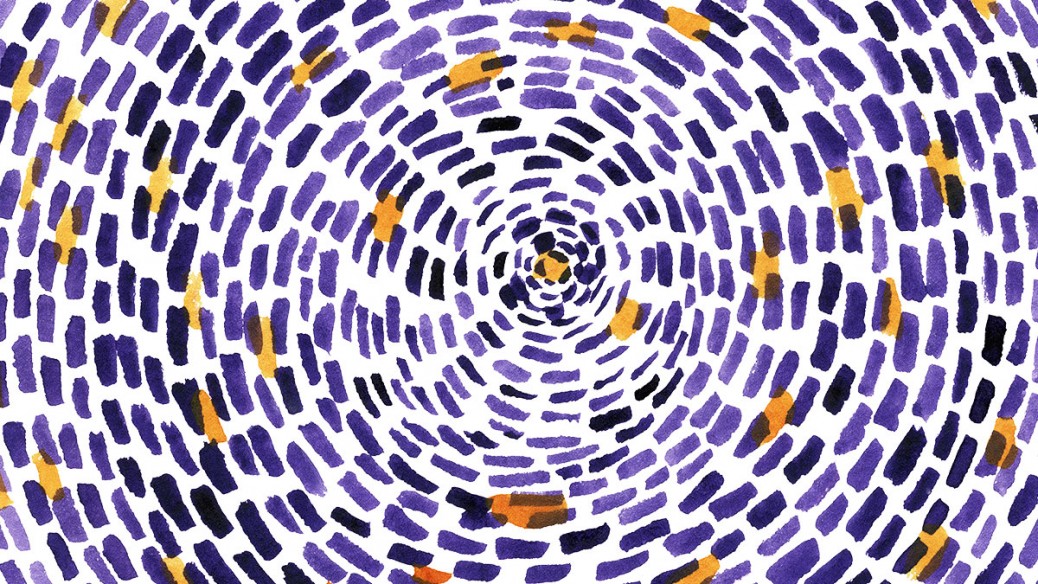Practice is a sort of conditioning at physical and mental levels, and it is through conditioning that society makes man its slave. In that case how can Patanjali’s practice be an instrument of liberation?
Society conditions you to make a slave out of you, an obedient member, so the question seems valid-how a continuous reconditioning of the mind can make you liberated? The question seems valid only because you are confusing two types of conditioning.
You have come to me, you have traveled a path. When you will be going back, you will travel the same path again. The mind can ask, “The path which brought you here, how it can take you back, the same path?” The path will be the same, your direction will be different – quite the opposite. While you were coming towards me you were facing towards me, when going back you will be facing the opposite direction – the path will be the same.
The society conditions you to make an obedient member, to make you a slave. Just a path. The same path has to be traveled to make you free, only the direction will be the opposite. The same method has to be used to “uncondition” you.
I remember one parable. Once Buddha came to his monks; he was going to deliver a sermon. He sat under his tree. He was having a handkerchief in his hand. He looked at the handkerchief. The whole congregation also looked at what he was doing. Then he binds five knots in the handkerchief and then he asks, “What should I do now to unknot this handkerchief? What should I do now?” And he asked two questions. One: “Is the handkerchief the same when there were no knots on it or is it different?”
One bhikkhu, one monk, says that, “In a sense it is the same because the quality of the handkerchief has not changed. Even with knots it is the same, the same handkerchief. The inherent nature remains the same. But in a sense it has changed because something new has appeared. Knots were not there, now knots are there. So superficially it has changed, but deep down it has remained the same.”
Buddha says, “This is the situation of the human mind. Deep down it remains unknotted. The quality remains the same.” When you become a Buddha, an enlightened one, you will not have a different consciousness. The quality will be the same. The difference is only that now you are a knotted handkerchief; your consciousness has a few knots.
Second thing Buddha asked: “What should I do to unknot the handkerchief?” Another monk says, “Unless we know what you have done to knot it we cannot say anything, because the reverse process will have to be applied. The way you have knotted it has to be known first, because that will be the way again in the reverse order to unknot.” So Buddha says, “This is the second thing. How you have come into this bondage, this has to be understood. How you are conditioned in your bondage, this has to be understood, because the same will be the process, in reverse order, to uncondition you.”
If attachment is the conditioning factor, then non-attachment will become the unconditioning factor. If expectation leads you in misery, then non-expectation will lead you into non-misery. If anger creates a hell within you, then compassion will create a heaven. So whatsoever the process of misery, the reverse will be the process of happiness. Unconditioning means you have to understand the whole knotted phenomenon of human consciousness as it is. This whole process of yoga will be nothing understanding the complex knots and then unknotting them, unconditioning them. It is not a reconditioning, remember. It is simply unconditioning; it is negative. If it is a reconditioning, then you will become a slave again – a new type of slave in a new imprisonment. So this difference has to be remembered: it is unconditioning, not reconditioning.
What is the difference? Take some actual examples. You feel anger. Anger is a conditioning; you have learned it. Psychologists say that it is a learning; it is a programmed thing. Your society teaches it to you. There are societies even now which never get angry, the members never get angry. There are societies, small tribal clans still in existence, which have never known any fight, no war.
In the Philippines, a small aboriginal tribe exists. For three thousand years it has not known any fight, not a single murder, not a single suicide. What has happened to it? And they are the most peace-loving people, the most happy possible. Their society from the very beginning never conditions them for anger. In that tribe, even in your dream if you kill someone, you have to go and ask his forgiveness – even in dream. If you are angry with someone and fighting, the next day you have to declare to the village that you have done something wrong. Then the village will gather together, and the wise men of the village will diagnose your dream and they will suggest what is to be done now – even small children!
Psychologists say that hate or anger are not natural. Love is natural: hate and anger are just created. They are hindrances in love, and society conditions you for them. Unconditioning means whatsoever the society has done, it has done. There is no use going on condemning it; it is already the case. And by simply saying the society is responsible, you are not helped. It has been done. Now – right now what you can do, you can un-condition. So whatsoever your problems, look deep in the problem. Penetrate it, analyze it, and look how you are conditioned for it.
For example, there are societies which never feel competitive. Even in India, there are aboriginal tribes – no competition exists. Of course, they cannot be very progressive in our measurement, because our progress can only be through competition. They are not competitive. Because they are not competitive, they are not angry, they are not jealous, they are not so hate-filled, they are not so violent. They don’t expect much, and whatsoever their life gives to them they feel happy and grateful.
To you, whatsoever life gives… you will never feel grateful. You will always be frustrated because you can always ask more. And there is no end to your expectations and desires. So if you feel miserable, look into the misery and analyze it. What are the conditioning factors which are creating the misery? And there is not much difficulty to understand. If you can create misery, if you are so capable of creating misery, there is no difficulty in understanding it. If you can create it, you can understand it.
Patanjali’s whole standpoint is this: looking into the misery of man, it is found that man himself is responsible. He is doing something to create it. That doing has become habitual, so he goes on doing it. It has become repetitive, mechanical, robot-like. If you become alert, you can drop out of it. You can simply say, “I will not cooperate.” The mechanism will start working.
Someone insults you. You just stand still, remain silent. The mechanism will start; it will bring the past pattern. The anger will be coming, the smoke will arise, and you will feel just on the verge of getting mad. But you stand. Don’t cooperate and just look at what the mechanism is doing. You will feel wheels within wheels within you, but they are impotent because you are not cooperating.
Or, if you feel it impossible to remain in such a still state, then close your door, move into the room, have a pillow before you, and beat the pillow. And be angry with the pillow. And when you are beating on, getting angry and mad with the pillow, just go on watching what you are doing, what is happening, how the pattern is repeating itself.
If you can stand still, that’s the best. If you feel it is difficult, you are pulled, then move into a room and be angry on the pillow. Because with the pillow, your madness will be totally visible to you; it will become transparent. And the pillow is not going to react; you can watch more easily. And there is no danger, no safety problem. You can watch. Slowly, the rising of the anger and the decline of the anger.
Watch both, the rhythm. And when your anger is exhausted, you don’t feel like beating the pillow any more, or you have started laughing or you feel ridiculous, close your eyes, sit on the floor, and meditate on what has happened. Do you still feel anger for the person who has insulted you, or it is thrown onto the pillow? You will feel a certain calmness falling on you. And you will not feel angry now with the person concerned. Rather, you may even feel compassion for him.
If you can stand still when some old pattern grips your mind, it is good. If you cannot, then allow it to happen in a dramatic way, but alone, not with someone. Because whenever you enact your pattern, allow your pattern with someone, it creates new reactions and it is a vicious circle.
The most significant point is to be watchful of the pattern – whether you are standing silently or acting your anger and hate out – watchful, looking how it uncoils. And if you can see the mechanism, you can undo it.
All the steps in yoga are just for undoing something which you have been doing. They are negative; nothing new is to be created. Only the wrong is to be destroyed, and the right is already there. Nothing positive is to be done, only something negative. The positive is hidden there. It is just like a stream is there, hidden under a rock. You are not to create the stream. It is already there, knocking; wants to be released and to become free and flowing. A rock is there. The rock has to be undone. Once the rock is removed, the stream starts flowing.
Bliss, happiness, joy or whatsoever you call it is there already flowing in you. Only some rocks are there. Those rocks are the conditionings of the society. Un-condition them. If you feel attachment is the rock, then make efforts for non-attachment. If you feel anger is the rock, then make efforts for non-anger. If you feel greed is the rock, then make efforts for non-greed. Just do the opposite. Don’t suppress greed. Just do the opposite: do something which is non-greed. Just don’t suppress anger; do something which is non-anger.
In Japan, when someone gets angry, they have a traditional teaching. If someone gets angry, immediately he has to do something which is non-anger. And the same energy which was going to move into anger moves into non-anger. Energy is neutral. If you feel angry with someone and you want to slap his face, give him a flower and see what happens.
You wanted to slap his face; you wanted to do something – that was anger. Give him a flower and just watch what is happening within you – you are doing something which is, of non-anger. And the same energy which was going to move your hand will move your hand. And the same energy which was going to hit him is now going to give the flower. But the quality has changed. You have done something. And the energy is neutral. If you don’t do something, then you suppress – and suppression is poisonous. Do something, but just the opposite. And this is not a new conditioning, it is just to uncondition the old. When the old has disappeared, the knots have disappeared, you need not worry for anything to do. Then you can flow spontaneously.
Tags: Patanjali Un-Condition










